
TLC for TLBs
By Doug Dahlgren*
Features Tech tipsWhen the compact tractor loader backhoe (TLB) was first introduced several years ago, many saw it as a toy,or simply a not-so-serious, smaller version of the full-size TLB.
Maintenance tips to keep compact tractor loader backhoes on the jobsite
and productive
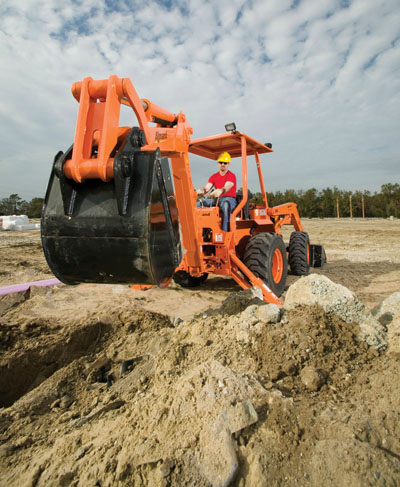 |
| Because of their extended versatility and ease of use, compact TLBs have become very popular in the rental market.
|
When the compact tractor loader backhoe (TLB) was first introduced several years ago, many saw it as a “toy,” or simply a not-so-serious, smaller version of the full-size TLB. But as time went on and this machine gained jobsite experience, rental operators started to realize that the compact TLB offered a nuance over its larger equipment cousin that justified its place in the rental market, mainly in performance combined with manoeuvrability.
Though these smaller machines could not approach the power and payload of the full-size TLB, they could still offer the necessary capabilities to answer many tasks, while being compact enough to get into areas inaccessible to larger machines.
With its ever-increasing versatility and acceptance in the market, the compact TLB has experienced a boom in terms of usage and demand. But with increased demand comes increased responsibility for the rental operator. Though these machines are built for rugged use, the more time they spend in the unforgiving conditions of most jobsites, the more need there is for proper maintenance to avoid costly downtime. It is a fact that with time and continued use, all equipment will inevitably fail, regardless of how well built. It is also a fact that conducting proper maintenance while recognizing and responding to common equipment warning signs will maximize the life of any piece of equipment.
By following some tips on how to properly maintain a compact TLB rental companies can and further its reputation as a versatile and dependable jobsite ally for customers.
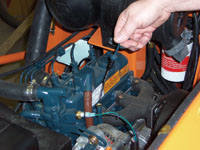 |
|
| Rental operators understand that rental customers will not do routine checks or maintenance on their machines. It is necessary to check the engine oil before every operation. |
Where is the owner’s manual?
Perhaps the most logical resource for maintenance information, regardless of the type of equipment, is the owner’s manual. It includes suggested maintenance schedules and procedures, inspection checklists, troubleshooting tips, proper operational techniques and safety information. Unfortunately, few give manuals the attention they deserve before operating equipment. In fact, it is not unusual to find the operator’s manual still sealed and protected within its original plastic bag years after the equipment has been put in service.
One possible reason for this is that some assume that maintenance requirements and other vital information is roughly the same for different pieces of equipment. Even when looking specifically at compact TLBs, different models are built with different components, so that a one-size-fits-all approach is not sufficient.
The first step a rental company should take when purchasing a new or used piece of equipment is to consult the manual and develop a maintenance program based on the manufacturer’s recommendations. Most manuals will clearly detail the appropriate maintenance schedule for individual equipment models. If the manual cannot be found, try the manufacturer’s website. Most leading manufacturers will have manuals readily available online for convenient access. The key is to understand that this information is provided so customers can get the most out of a manufacturer’s piece of equipment. The next step is to pay attention to this information and then understand how the manufacturer expects it to be used.
An example of a daily, or eight-hour, maintenance checklist for a diesel compact TLB:
- Check engine oil level, fill if needed.
- Check battery electrolyte level.
- Check fan belt for tightness.
- Check oil cooler fins, clean as necessary.
- Check radiator hoses and clamps for leaks.
- Check fuel lines for leaks.
- Check air cleaner element.
- Check electrical wiring for damaged or loose connections.
- Tighten lug nuts to 80 ft/lbs.
- Check hydraulic oil level, fill if necessary.
- Check all fasteners for tightness.
- Check backhoe bucket teeth, replace if necessary.
- Grease all swivel points (loader and backhoe).
- Check hydraulic hoses for damage and loose connections.
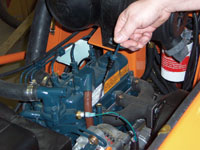 |
|
| The owner’s manual will list various maintenance needs for the machine, including how often items such as filters should be checked, cleaned and replaced.
|
|
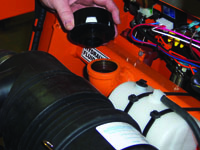 |
|
| If any fluid, such as hydraulic fluid, is low, mechanics or operators should investigate further to determine why the levels are down.
|
Do manufacturers really expect mechanics and operators to conduct multiple checks before and after each use? The simple answer is “no.” Some items should be checked daily without question, such as checking the engine oil, but what manufacturers are trying to do with such substantial daily checklists is provide a guideline for what areas need regular monitoring.
For example if you do not tighten the lug nuts every day, you should be aware that these are areas that need regular attention, and know that they can’t be put off for weeks or months at a time. At the very least, the mechanic or operator should do a daily walkthrough of the equipment, while keeping this list of checks in mind.
Clean the machine
But before doing that daily walkthrough, make sure the machine is clean. It is ironic how some view equipment. People will spend hours each week making sure their personal vehicle is spotless, whereas the perception of a piece of equipment is that since it is designed to work in the dirt, it should be dirty, and they just leave it caked with mud and collecting dust. In actuality, much more value comes out of keeping equipment clean as customers tend to treat rented equipment better.
While keeping machinery clean yields aesthetic value to the customer, it also results in easier-to-spot maintenance issues, less extensive repairs and greater uptime.
Many times repair events begin with signs of wear or component failure, such as cracks and fluid leaks. And if the machine is covered with dirt and grime, it is possible these signs can go unnoticed until they become something worse, potentially resulting in equipment failure.
Furthermore, filth can hide exterior equipment damage, such as dents and other evidence of operator misuse. Cleaning the equipment could reveal this damage and cue the mechanic to investigate further to check for potential internal issues that lie behind a dent.
Additionally, from time to time it is important to clean what is under the hood as well, but make sure to do it appropriately. Always wait until the engine and hydraulic system are cool before cleaning. Cold water on a hot engine or hydrostatic pump can cause costly damage. Also, do not direct the stream of a pressure washer directly at the hydraulic system breather since it is possible that water could get into the hydraulic system and contaminate the fluid.
Listen to the machine
Beyond the potential maintenance issues one can determine through routine checks and walkthroughs, it is important for operators to pay attention to other issues the equipment may be indicating through other sights, sounds or smells.
Some of the most common indications of trouble include smoke, performance loss, squealing belts and other uncommon engine noises such as knocking sounds. All of these are symptoms of burgeoning problems and should be addressed as such to prevent larger, more costly issues from developing. Remember, any change in operation is a signal that maintenance is needed.
In most situations, combining all these tips will create a suitable maintenance routine for the TLB. But what about TLBs that do not enjoy the comforts of warm weather year round?
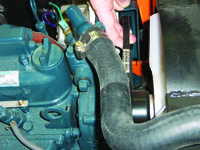 |
|
| While it is not necessary to check the fan belt before every operation, it should be monitored regularly to be sure it is tight and there are no visible signs of wear or damage.
|
When the temperature drops
Because cold weather environments are harder on equipment, maintenance becomes more of a critical issue than in warm weather. Simple tasks such as checking oil, cleaning filters and fuelling the equipment need special attention. For example, fuel tanks need to be kept full or close to full at all times to prevent condensation from building up inside the tank. Condensation can cause a number of engine problems including blocked fuel lines and plugged oil filters, so it is also a good idea to check the filters more frequently during cold weather operation.
Engine oil must still be checked every day, and may need to be changed to the proper viscosity, relative to the temperature. The owner’s manual is the best point of reference, as it contains special recommendations for the oil, based on the temperature the equipment is being operated in.
One of the biggest problems associated with engines and cold weather is the battery. A battery has approximately half of its capacity at -18 C than it does at 27 C. Ensuring the battery is in good condition and fully charged will increase the likelihood of quick engine starts.
And finally, be patient with the equipment. Allowing the machine ample time to warm up will result in less chance of damage to the engine and hydraulic system. Just as a person would allow a car to warm up in cold weather, a TLB needs a chance to elevate its temperature before going to work.
Shop around
Of course, it is important to conduct routine maintenance and watch for signs of problems with any piece of equipment, but is it possible to reduce maintenance requirements before ever purchasing a compact TLB? Yes, that is why a potential buyer should take the time to study the available equipment and determine several “maintenance-free” features that some manufacturers are building into their equipment.
Due to their extended versatility and ease of use, compact TLBs have become very popular in the rental market. This rental popularity, in turn, has led to benefits for all owners and operators of compact TLBs.
In the rental market, a machine with low maintenance requirements is of primary importance. Manufacturers and rental operators alike fully understand that the rental customer will not be conducting any routine checks or maintenance on their machines. Renters need a machine to do a certain job and there is no way they are going to spend any rental time maintaining someone else’s machine. All of this maintenance must be done by the rental operator, and the faster it can be completed and the machine can be back out on rent, the better.
Some manufacturers have been building their machines to be more robust and better able to handle the rigours of rental, which results in better equipment for all. Features such as oversized pins on all areas of articulation, composite bearings and sealed joints to keep dirt out and grease in, and the elimination of metal-on-metal contact in the backhoe joints all contribute to machines with greatly reduced maintenance requirements. These machines typically offer more smooth and precise operation, which contributes to better productivity.
Obviously, it is in a manufacturer’s best interests to continue to build compact TLBs with better components to increase durability and reduce maintenance concerns, but there will never be a machine that does not require some regular care. That is why these same manufacturers pour thousands of dollars into documentation, websites and other customer service devices. All that remains is for the end-user to “use” it. No matter how well built the machine, use the manufacturer’s documentation to develop a maintenance strategy, follow it and watch for warning signs. It may take some extra time, but the result is reduced headaches and a reliable investment that keeps paying dividends for years to come. ■
* Doug Dahlgren is the product manager for Allmand Bros. Inc.
Print this page
Leave a Reply